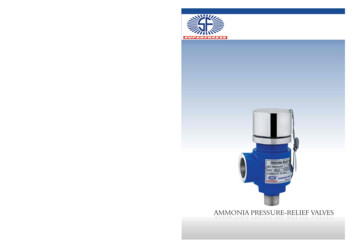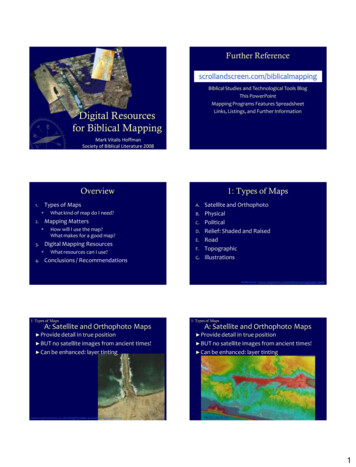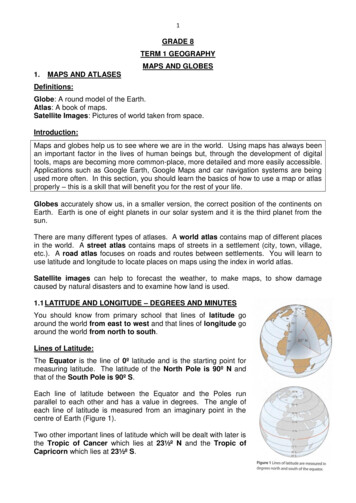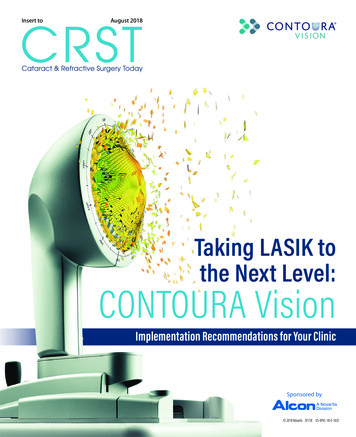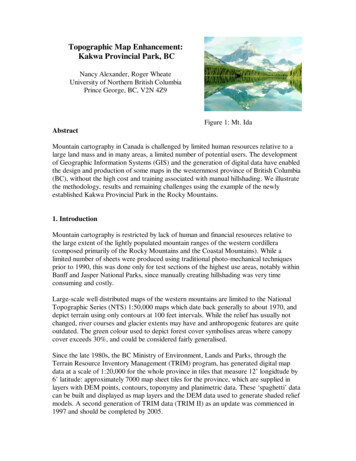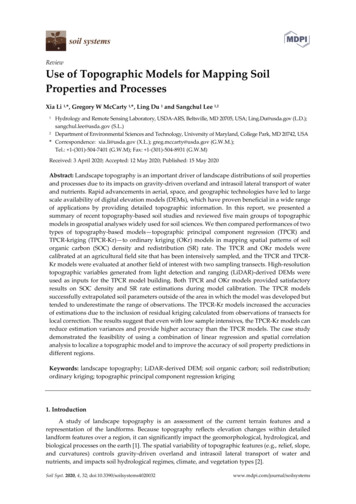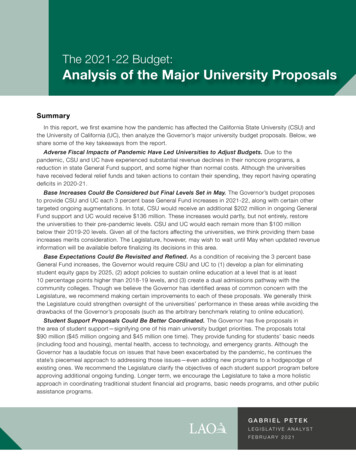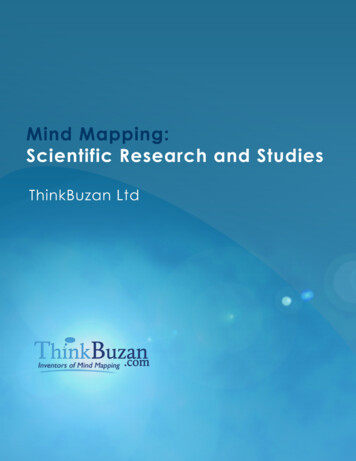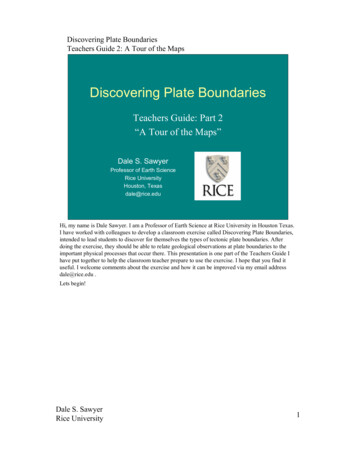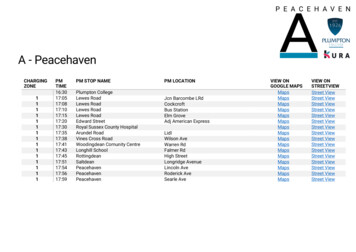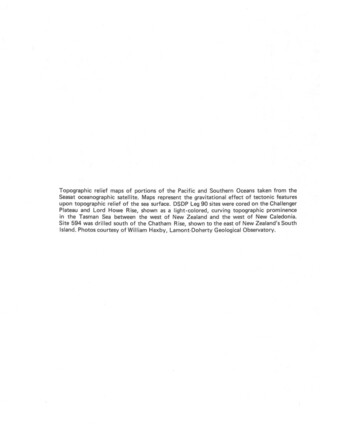
Transcription
Topographic relief maps of portions of the Pacific and Southern Oceans taken from theSeasat oceanographic satellite. Maps represent the gravitational effect of tectonic featuresupon topographic relief of the sea surface. DSDP Leg 90 sites were cored on the ChallengerPlateau and Lord Howe Rise, shown as a light-colored, curving topographic prominencein the Tasman Sea between the west of New Zealand and the west of New Caledonia.Site 594 was drilled south of the Chatham Rise, shown to the east of New Zealand's SouthIsland. Photos courtesy of William Haxby, Lamont-Doherty Geological Observatory.
Initial Reportsof theDeep Sea Drilling ProjectA Project Planned by and Carried Out With the Advice of theJOINT OCEANOGRAPHIC INSTITUTIONS FOR DEEP EARTH SAMPLING (JOIDES)VOLUME XC, Part 1covering Leg 90 of the cruises of the Drilling Vessel Glomar ChallengerNoumea, New Caledonia, to Wellington, New ZealandDecember 1982-January 1983PARTICIPATING SCIENTISTSJames P. Kennett, Christopher C. von der Borch, Paul A. Baker,Charles E. Barton, Anne Boersma, Jean Pierre Caulet,Walter C. Dudley, Jr., James V. Gardner, D. Graham Jenkins,William H. Lohman, Erlend Martini, Russell B. Merrill,Roger Morin, Campbell S. Nelson, Christian Robert,M. S. Srinivasan, Rüdiger Stein, and Akira TakeuchiSHIPBOARD SCIENCE REPRESENTATIVERussell B. MerrillEDITORJan H. BlakesleePrepared for theNATIONAL SCIENCE FOUNDATIONNational Ocean Sediment Coring ProgramUnder Contract C-482By theUNIVERSITY OF CALIFORNIAScripps Institution of OceanographyPrime Contractor for the Project
This material is based upon research supported by the National Science Foundation under Contract No. C-482.Any opinions, findings, and conclusions or recommendations expressed in this publication are those of the author(s) and do notnecessarily reflect the views of the National Science Foundation.It is recommended that reference to the whole or to part of this volume be made in one of the following forms, as appropriate:Kennett, J. P., von der Borch, C. C , et al., 19Init. Repts.DSDP, 90: Washington (U.S. Govt. Printing Office).Elmstrom, K. M., and Kennett, J. P., 19Late Neogene paleoceanographic evolution of Site 590: southwest Pacific. In Kennett, J. P., von der Borch, C. C , et al., Init. Repts. DSDP, 90:Washington (U.S. Govt. Printing Office),-Effective Publication Dates of DSDP Initial ReportsAccording to the International Code of Zoological Nomenclature, the date ofpublication of a work and of a contained name or statement affecting nomenclatureis the date on which the publication was mailed to subscribers, placed on sale, orwhen the whole edition is distributed free of charge, mailed to institutions andindividuals to whom free copies are distributed. The mailing date, not the printeddate, is the correct one.Mailing dates of the more recent Initial Reports of the Deep Sea Drilling Projectare as follows:Volume 79—November, 1984Volume 80—March, 1985Volume 81—January, 1985Volume 82—June, 1985Volume 83—April, 1985Volume 84—May, 1985Printed January 1986Library of Congress Catalog Card Number 74—603338For sale by the Superintendent of Documents, U.S. Government Printing OfficeWashington, D.C. 20402Stock Number038-000-00561-8
The world's first major oceanographic expedition took place between 1872 and 1876. Thisexpedition, aboard the H.M.S. Challenger covering nearly 70,000 nautical miles and gatheringoceanographic data from 362 stations, expanded our knowledge of the ocean and provided asolid foundation for future studies in marine geology. A century later, another vessel also namedChallenger continued to expand our knowledgeof the world's ocean and helped revolutionize ourconcepts of how the seafloor and the continentsform and change. The drilling vessel GlomarChallenger sailed the same waters as its historiccounterpart, seeking answers to new questionsconcerning the history of our planet and the lifeit supports. The continued advancement ofknowledge about the fundamental processes anddynamics of the earth is leading to a greater understanding of our planet and more intelligentuse of its resources.Since 1968, the Deep Sea Drilling Project(DSDP) has been supported by the National Science Foundation, primarily through a contractwith the University of California which, in turn,subcontracted to Global Marine Incorporated forthe services of the D/V Glomar Challenger.Through contracts with Joint OceanographicInstitutions, Inc. (JOI, Inc.), the National Science Foundation supported the scientific advisory structure for the project and funded predrilling geophysical site surveys. Scientific planningwas conducted under the auspices of the JointOceanographic Institutions for Deep Earth Sampling (JOIDES). The JOIDES advisory groupconsisted of over 250 members who made up 24committees, panels, and working groups. Themembers were distinguished scientists from academic institutions, government agencies, andprivate industry all over the world.In 1975, the International Phase of OceanDrilling (IPOD) began. The IPOD member nations, Federal Republic of Germany, Japan, United Kingdom, Soviet Union, and France, partially supported the project. Each member nationactively participated in the scientific planning ofthe project through membership in JOIDES. Scientists from these countries also took part in thefield work aboard the D/V Glomar Challengerand postcruise scientific studies.
The first ocean coring operations for the DeepSea Drilling Project began on August 11, 1968.During the ensuing years of drilling operationsin the Atlantic, Pacific, and Indian oceans, theGulf of Mexico, Caribbean Sea, MediterraneanSea, and Antarctic waters, the scientific objectives that had been proposed were successfullyaccomplished. Primarily, the age of the ocean basins and their processes of development were determined. The validity of the hypothesis of seafloor spreading was firmly demonstrated and itsdynamics studied. Emphasis was placed on broadreconnaissance and testing the involvement ofmid-oceanic ridge systems in the development ofthe ocean basin. Later legs of the Challengersvoyages concentrated on the nature of the oceanic crust, the sedimentary history of the passive ocean margins, sediment dynamics along active ocean margins, and other areas of interest.The accumulated results of this project have ledto major new interpretations of the pattern ofsedimentation and the physical and chemical characteristics of the ancient oceans.Technological advances have provided newtools which in turn have opened new dimensionsof scientific discovery. The introduction of theHydraulic Piston Corer in 1979 permitted virtually undisturbed cores of soft sediment layers tobe obtained. This technological advance hasgreatly enhanced the ability of scientists to studyancient ocean environments, as recorded by sediment characteristics and flora and fauna preserved in these deposits.A second major advance has been the use ofthe hole after drilling. The project routinely log-VIged holes and performed geophysical and geochemical studies before, during, and after drilling. Long-term downhole geophysical seismicmonitoring devices have been implanted successfully in DSDP holes. These new listening devicesand geophysical studies have provided valuableinformation about the origin and nature of thedynamic processes of plate tectonics.These reports contain the results of the initialstudies of the recovered core material and the associated geophysical information. All the world'speople benefit either directly or indirectly fromthis fundamental research. Knowledge about pastand present conditions and processes are thefoundations for future predictions and developments. Both short- and long-term benefits are obtained by advances in drilling technology and instrumentation. Information is being obtainedabout the origin and geographic distribution ofnatural resources. Just as the H.M.S. Challenger had a profound impact on scientific thoughtfor over a century, this second Challenger expedition has given a greater understanding of theoceans and the processes that form and shape theearth.Erich Bloch,DirectorWashington, D.C.
]pI*O I C θRecognizing the need in the oceanographiccommunity for scientific planning of a programto obtain deep sedimentary cores from theocean bottoms, four of the major oceanographic institutions that had strong interests andprograms in the fields of marine geology andgeophysics formed, in May 1964, the JointOceanographic Institutions for Deep EarthSampling (JOIDES). This group, LamontDoherty Geological Observatory; RosenstielSchool of Marine and Atmospheric Science,University of Miami; the Scripps Institution ofOceanography, University of California at SanDiego; and the Woods Hole Oceanographic Institution, expressed an interest in undertakingscientific planning and guidance of thesedimentary drilling program. It was the purpose of this group to foster programs to investigate the sediments and rocks beneath thedeep oceans by drilling and coring. Themembership of this original group was laterenlarged in 1968 when the University ofWashington became a member, and again in1975 when University of Hawaii Institute ofGeophysics, the Oregon State UniversitySchool of Oceanography, the University ofRhode Island Graduate School of Oceanography, and Texas A&M University Department ofOceanography became members. In accordancewith international agreements, institutionsof participating nations became members ofJOIDES. Thus, during 1974 to 1976, theBundesanstalt für Geowissenschaften undRohstoffe of the Federal Republic of Germany,the Centre National pour 1'Exploitation desOceans of France, the Natural EnvironmentResearch Council of the United Kingdom, theUniversity of Tokyo of Japan, and Academy ofSciences of the USSR became JOIDES members.Through discussions sponsored by theJOIDES organization, with support from theNational Science Foundation, ColumbiaUniversity's Lamont-Doherty GeologicalObservatory operated a drilling program in thesummer of 1965, on the Blake Plateau regionoff Jacksonville, Florida.vn
With this success in hand, planning beganfor a more extensive deep sea effort. Thisresulted in the award of a contract by theNational Science Foundation to the Scripps Institution of Oceanography, University of California at San Diego for an eighteen-monthdrilling program in the Atlantic and Pacificoceans, termed the Deep Sea Drilling Project(DSDP). Operations at sea began in August1968, using the now-famous drilling vessel, theGlomar Challenger.The goal of the Deep Sea Drilling Projectis to gather scientific information that will helpdetermine the age and processes of development of the ocean basins. The primary strategyis to drill deep holes into the ocean floor, relying largely on technology developed by thepetroleum industry.Through the efforts of the principal organizations and of the panel members, whowere drawn from a large cross section of leading earth scientists and associates, a scientificprogram was developed.Cores recovered from deep beneath theocean floor provide reference material for amultitude of studies in fields such as biostratigraphy, physical stratigraphy, and paleomagnetism that afford a new scope for investigatingthe physical and chemical aspects of sedimentprovenance, transportation, deposition, anddiagenesis. In-hole measurements, as feasible,provide petrophysical data to permit inferenceof lithology of intervals from which no coreswere recovered.A report, describing the core materials andinformation obtained both at sea and in laboratories onshore, is published after the completion of each cruise. These reports are acooperative effort of shipboard and shorebased scientists and are intended primarily to bea compilation of results which, it is hoped, willbe the starting point for many future new andexciting research programs. Preliminary interpretations of the data and observations taken atsea are also included.Core materials and data collected on eachcruise will be made available to qualified scientists through the Curator of the Deep Sea Drill-Vllling Project, following a Sample DistributionPolicy (p. xvii) approved by the National Science Foundation.The advent of Glomar Challenger, with itsdeep-water drilling capability, is exceedinglytimely. It has come when geophysical investigation of the oceans has matured through 20 to 30years of vigorous growth to the point where wehave some knowledge about much of the formerly unknown oceanic areas of our planet.About one million miles of traverses have beenmade which tell us much about the global pattern of gravity, magnetic and thermal anomalies, and about the composition, thickness, andstratigraphy of the sedimentary cover of thedeep sea and continental margin. The coveragewith such data has enabled the site selectionpanels to pick choice locations for drilling. Theknowledge gained from each hole can be extended into the surrounding area. Detailed geophysical surveys were made for most of theselected locations prior to drilling.The earth sciences have recently maturedfrom an empirical status to one in which substantial theories and hypotheses about majortectonic processes are flourishing. Theoriesabout the origin of magnetic fields and magnetic reversals, about ocean floor spreading andcontinental drift, and about the thermal historyof our planet have led to specific predictionsthat could be tested best by an enlightened program of sampling of deep sea and continentalmargin sediments and underlying rocks.In October 1975, the International Phaseof Ocean Drilling (IPOD) began. This international interest, and the true participationof both the scientists and governments of anumber of nations, are eloquent testimony tothe importance of the work being done by theDeep Sea Drilling Project.The members of JOIDES and DSDP andthe scientists from all interested organizationsand nations who have served on the various advisory panels are proud to have been of serviceand believe that the information and core materials that have been obtained will be of valueto students of earth sciences and to all humanity for many years to come.
Deep SeaDrilling ProjectMEMBER ORGANIZATIONS OF THE JOINTOCEANOGRAPHIC INSTITUTIONS FOR DEEPEARTH SAMPLING (JOIDES):1Bundesanstalt für Geowissenschaften und Rohstoffe,Federal Republic of GermanyUniversity of California at San Diego,Scripps Institution of OceanographyCentre National pour TExploitation des Oceans, ParisColumbia University, Lamont-Doherty GeologicalObservatoryOPERATING INSTITUTIONScripps Institution of OceanographyUniversity of California at San DiegoLa Jolla, CaliforniaW. A. Nierenberg, DirectorDEEP SEA DRILLING PROJECTDr. M. N. A. PetersonPrincipal InvestigatorProject ManagerUniversity of Hawaii, Hawaii Institute of GeophysicsMr. Robert S. BowerAssistant Project Manager forAdministration and ContractsUniversity of Miami, Rosenstiel School of Marine andAtmospheric ScienceDr. Yves LancelotChief ScientistNatural Environment Research Council, LondonOregon State University, School of OceanographyMr. Ed DeanFinance AdministratorUniversity of Rhode Island, Graduate School ofOceanographyMs. Sue StrainPersonnel OfficerTexas A&M University, Department of OceanographyUniversity of Tokyo, Ocean Research InstituteUniversity of Washington, Department ofOceanographyU.S.S.R. Academy of Sciences2Woods Hole Oceanographic InstitutionUniversity of Texas at AustinIncludes member organizations during time of cruise.This institution and its committees and panel members were noncontributing members of JOIDES at time of cruise.IX
Participants aboardGLOMAR CHALLENGER for Leg NinetyDr. James P. KennettCo-Chief ScientistGraduate School of OceanographyUniversity of Rhode IslandNarragansett, Rhode Island 02882-1197Mr. William H. LohmanPaleontologist (nannofossils)Marathon Oil CompanyDenver Research CenterLittleton, Colorado 80160Dr. Christopher C. von der BorchCo-Chief ScientistSchool of Earth SciencesFlinders University of South AustraliaBedford ParkSouth Australia 5042Dr. Erlend MartiniPaleontologist (nannofossils)Geologisch-Palaon tologisches InstitutJohann- Wolfgang-Goethe- UniversitàtD-6000 Frankfurt am MainFederal Republic of GermanyDr. Paul A. BakerSedimentologistDepartment of GeologyDuke UniversityDurham, North Carolina 27708Dr. Charles E. BartonPaleomagnetistGraduate School of OceanographyUniversity of Rhode IslandNarragansett, Rhode Island 02882-1197Dr. Anne BoersmaPaleontologist (benthic foraminifers)MicroclimatesStony Point, New York 10980Dr. Jean Pierre CauletPaleontologist (radiolarians)Laboratoire de GéologieMuseum National d'Histoire Naturelle75005 Paris, FranceDr. Walter C. Dudley, Jr.SedimentologistNatural Sciences DivisionCollege of Arts and SciencesUniversity of Hawaii at HiloHilo, Hawaii 96720Dr. Russell B. MerrillIgneous Petrologist/Staff Science RepresentativeDeep Sea Drilling Project, A-031Scripps Institution of OceanographyLa Jolla, California 92093Dr. Roger MorinPhysical Properties SpecialistDepartment of Earth and Planetary SciencesMassachusetts Institute of TechnologyCambridge, Massachusetts 02139Dr. Campbell S. NelsonSedimentologistDepartment of Earth SciencesUniversity of WaikatoHamilton, New ZealandDr. Christian RobertSedimentologistLaboratoire de Géologie MarineCentre Universitaire de Luminy13288 Marseille Cedex 09FranceDr. James V. GardnerSedimentologistPacific-Arctic Branch of Marine GeologyU.S. Geological SurveyMenlo Park, California 94025Dr. M. S. SrinivasanPaleontologist (planktonic foraminifers)Department of GeologyBanaras Hindu UniversityVaranasi 221 005IndiaDr. D. Graham JenkinsPaleontologist (planktonic foraminifers)Department of Earth SciencesOpen UniversityMilton Keynes MK7 6AAUnited KingdomDr. Rüdiger SteinSedimentologistGeologisch-Palaontologisches InstitutChristian-Albrechts-Universitàt Kiel2300 KielFederal Republic of GermanyXI
Mr. Frank Sanchez, Jr.Electronics TechnicianDeep Sea Drilling Project, A-031Scripps Institution of OceanographyLa Jolla, California 92093Dr. Akira TakeuchiSedimentologistDepartment of Earth SciencesFaculty of ScienceToyama UniversityGohuku3I90, Toyama 930JapanMr. David HueyCruise Operations ManagerDeep Sea Drilling Project, A-031Scripps Institution of OceanographyLa Jolla, California 92093Captain Joseph A. ClarkeMaster of the Drilling VesselGlobal Marine Drilling Co.San Diego, California 92111Mr. Craig HallmanMarine TechnicianDeep Sea Drilling Project, A-031Scripps Institution of OceanographyLa Jolla, California 92093Mr. Blair J. McKayMarine TechnicianDeep Sea Drilling Project, A-031Scripps Institution of OceanographyLa Jolla, California 92093Mr. James A. RuddellDrilling SuperintendentGlobal Marine Drilling Co.San Diego, California 92111Mr. Will SooterMarine TechnicianDeep Sea Drilling Project, A-031Scripps Institution of OceanographyLa Jolla, California 92093Mr. Dennis K. GrahamLaboratory OfficerDeep Sea Drilling Project, A-031Scripps Institution of OceanographyLa Jolla, California 92093Mr. Thomas W. WitteMarine TechnicianDeep Sea Drilling Project, A-031Scripps Institution of OceanographyLa Jolla, California 92093Mr. Robert C. HaymanCuratorial RepresentativeDeep Sea Drilling Project, A-031Scripps Institution of OceanographyLa Jolla, California 92093Mr. Victor S. SoteloPhotographerDeep Sea Drilling Project, A-031Scripps Institution of OceanographyLa Jolla, California 92093Mr. James S. PineChemistDeep Sea Drilling Project, A-031Scripps Institution of OceanographyLa Jolla, California 92093Ms. Joanne R. CollinsYeopersonDeep Sea Drilling Project, A-031Scripps Institution of OceanographyLa Jolla, California 92093Deep Sea Drilling Project Publications StaffPublications ManagerJan H. BlakesleeProduction ManagerRaymond F. SilkArt-Photo SupervisorVirginia L. Roman (this volume)EditorsMarian G. BaileySusan OrlofskyKatie L. TurnerElizabeth WhalenProduction AssistantsElaine BruerMadeleine A. MahnkenIllustratorsAileen BobrykVicki CypherdKathleen SandersonAlice N. Thompson (this volume)xnProduction CoordinatorsCarolina BertlingMary A. Young
JOIDES AdvisoryGroups 1Executive CommitteeDr. D. James Baker, Jr.University of WashingtonProf. Dr. Friedrich BenderBundesanstalt für Geowissenschaften und RohstoffeDr. Alan Berman, ChairmanRosenstiel School of Marine and Atmospheric SciencesDr. John C. BowmanNatural Environment Research CouncilDr. Jacques DebyserCentre National pour VExploitation des OceansDr. G. Ross HeathOregon State UniversityDr. Charles E. HelsleyHawaii Institute of GeophysicsDr. Jose Honnorez(ex-officio Planning Committee Representative)Rosenstiel School of Marine and Atmospheric ScienceDr. John A. KnaussUniversity of Rhode IslandDr. Arthur MaxwellUniversity of Texas at AustinDr. Noriyuki NasuUniversity of TokyoDr. William A. NierenbergScripps Institution of OceanographyDr. Melvin N. A. Peterson (ex-officio)Scripps Institution of OceanographyDr. Barry RaleighLamont-Doherty Geological ObservatoryDr. Robert D. ReidTexas A&M UniversityDr. Alexander V. SidorenkoU.S.S.R. Academy of SciencesDr. John SteeleWoods Hole Oceanographic InstitutionPlanning CommitteeDr. Jean AubouinUniversité Pierre et Marie CurieDr. Helmut BeiersdorfBundesanstalt für Geowissenschaften und RohstoffeDr. William R. BryantTexas A&M UniversityDr. Richard T. BufflerUniversity of Texas at AustinDr. Joe R. CannUniversity of Newcastle- Upon- TyneMembership at time of cruise.Dr. Joe S. CreagerUniversity of WashingtonDr. Dennis E. HayesLamont-Doherty Geological ObservatoryDr. Jose Honnorez, ChairmanRosenstiel School of Marine and Atmospheric ScienceDr. James P. KennettUniversity of Rhode IslandDr. Kazuo KobayashiUniversity of TokyoDr. Yves Lancelot (ex-officio)Scripps Institution of OceanographyDr. Ralph MoberlyHawaii Institute of GeophysicsDr. Lev NikitinU.S.S.R. Academy of SciencesDr. Hans SchraderOregon State UniversityDr. Richard P. von HerzenWoods Hole Oceanographic InstitutionDr. Edward L. WintererScripps Institution of OceanographyAdvisory Panel on Sedimentary Petrologyand Physical PropertiesDr. Richard BennettNational Oceanic and Atmospheric AdministrationMr. Robert E. Boyce (ex-officio)Scripps Institution of OceanographyDr. Richard CarlsonTexas A&M UniversityDr. Walter E. Dean, Jr.U.S. Geological SurveyDr. George deVries Klein, ChairmanUniversity of Illinois, UrbanaDr. Leland KraftMcClelland Engineers, Inc.Dr. Michael T. LedbetterUniversity of Georgia, AthensDr. I. Nick McCaveUniversity of East AngliaDr. Frederic MélièresUniversité Pierre et Marie CurieDr. Ralph Moberly (ex-officio)Hawaii Institute of GeophysicsDr. Gregory MountainLamont-Doherty Geological ObservatoryDr. Peter RotheUniversitàt MannheimDr. Peter P. TimofeevU.S.S.R. Academy of Sciencesxiπ
Advisory Panel on Organic GeochemistryDr. Earl W. BakerFlorida Atlantic UniversityDr. Miriam Baltuck (ex-officio)Scripps Institution of OceanographyDr. Simon C. BrassellUniversity of BristolDr. Egon T. DegensUniversitàt HamburgDr. Eric GalimovU.S.S.R. Academy of SciencesDr. John M. HuntWoods Hole Oceanographic InstitutionDr. Keith A. KvenvoldenU.S. Geological SurveyDr. Philip A. MeyersUniversity of MichiganDr. Hans Schrader (ex-officio)Oregon State UniversityDr. Bernd R. T. Simoneit, ChairmanOregon State UniversityAdvisory Panel on Information HandlingDr. Daniel E. Appleman, ChairmanSmithsonian InstitutionDr. Joe S. Creager (ex-officio)University of WashingtonDr. John C. HathawayU.S. Geological SurveyDr. Alfred Loeblich, Jr.University of California, Los AngelesDr. Michael S. LoughridgeNational Oceanic and Atmospheric AdministrationDr. Marthe MelguenBureau National des Données OcéaniquesDr. Russell Merrill (ex-officio)Scripps Institution of OceanographyMrs. Judit NowakBundesanstalt für Geowissenschaften und RohstoffeDr. John B. SaundersNaturhistorisches Museum BaselDr. Valery V. ZdoroveninU.S.S.R. Academy of SciencesIndustrial Liaison PanelMr. R. L. AdamsConoco Inc.Prof. Nikolai P. BudnikovMinistry of Geology of the U.S.S.R.Mr. Melvin J. HillGulf Oil Exploration and Production CompanyDr. Ing. Guenter PetersonGewerkschaft WalterMr. W. A. Roberts, ChairmanEnergy Concepts, Inc.xivDr. Gilbert RutmanSociété Nationale des Pétroles d'AquitaineMr. G. WilliamsUnited Kingdom Offshore Operators Association, Ltd.Advisory Panel on Ocean CrustDr. Roger N. AndersonLamont-Doherty Geological ObservatoryDr. Henri BougaultCentre Océanologique de Bretagne (CNEXO)Dr. John R. DelaneyUniversity of WashingtonDr. Donald ElthonUniversity of HoustonDr. Rolf EmmermannUniversitàt GiessenDr. Kenneth C. MacDonaldUniversity of California, Santa BarbaraDr. Ralph Moberly (ex-officio)Hawaii Institute of GeophysicsDr. James Natland (ex-officio)Scripps Institution of OceanographyDr. Minoru OzimaUniversity of TokyoDr. Paul Robinson, ChairmanDalhousie UniversityDr. Hans SchoutenWoods Hole Oceanographic InstitutionDr. Ralph StephenWoods Hole Oceanographic InstitutionDr. John TarneyUniversity of LeicesterDr. Andrei A. TsvetkovU.S.S.R. Academy of SciencesAdvisory Panel on Ocean Margin (Active)Dr. Peter F. BarkerUniversity of BirminghamDr. Jean-Paul CadetUniversité d'OrléansDr. William Coulbourn (ex-officio)Scripps Institution of OceanographyDr. Darrel CowanUniversity of WashingtonDr. Joe S. Creager (ex-officio)University of WashingtonDr. Yury I. DmitrievU.S.S.R. Academy of SciencesDr. Dennis E. Hayes (ex-officio)Lamont-Doherty Geological ObservatoryDr. Donald M. Hussong, ChairmanHawaii Institute of GeophysicsDr. Daniel KarigCornell University
Dr. John W. LaddLamont-Doherty Geological ObservatoryDr. Kazuaki NakamuraUniversity of TokyoDr. Roland von HueneU.S. Geological SurveyDr. Hansjust WaltherBundesanstalt für Geowissenschaften und RohstoffeAdvisory Panel on Ocean Margin (Passive)Dr. Mikhail E. ArtemievU.S.S.R. Academy of SciencesDr. Arnold H. BoumaGulf Science and Technology CompanyDr. William R. Bryant (ex-officio)Texas A&M UniversityDr. Karl HinzBundesanstalt für Geowissenschaften und RohstoffeDr. Hideo KagamiUniversity of TokyoDr. Charlotte KeeneGeological Survey of CanadaDr. Yves Lancelot (ex-officio)Scripps Institution of OceanographyDr. Lucien MontadertInstitut Français du PétroleDr. David G. Roberts, ChairmanBritish Petroleum Co., Ltd.Dr. William B. F. RyanLamont-Doherty Geological ObservatoryDr. Sigmund SnelsonShell Oil CompanyDr. Jrirn ThiedeUniversitetet i OsloDr. Brian E. TucholkeWoods Hole Oceanographic InstitutionDr. Peter R. VailEXXON Production CompanyDr. Jan E. van HinteVrije UniversiteitDr. Edward L. Winterer (ex-officio)Scripps Institution of OceanographyAdvisory Panel on Pollution Prevention and SafetyDr. Nikolai I. BeliyMinistry of Gas Industry, U.S.S.R.Dr. Rustum Jean ByramjeeCompagnie Français des PétrolesDr. George ClaypoolU.S. Geological SurveyDr. Louis E. Garrison, ChairmanU.S. Geological SurveyDr. Arthur E. GreenEXXON Production Research LaboratoryDr. Jose Honnorez (ex-officio)Rosenstiel School of Marine and Atmospheric ScienceProf. A. J. HornAtherton, CaliforniaDr. Ernst HotzDeminex, Essen, Federal Republic of GermanyDr. Yves Lancelot (ex-officio)Scripps Institution of OceanographyDr. David B. MacKenzieMarathon Oil CompanyDr. Geoffrey D. TaylorBritish Petroleum Company, Ltd.Advisory Panel on Inorganic GeochemistryDr. Miriam Baltuck (ex-officio)Scripps Institution of OceanographyDr. Stephen E. CalvertUniversity of British ColumbiaDr. Joe R. Cann (ex-officio)University of Newcastle- Upon-TyneDr. Henry ElderfieldUniversity of LeedsDr. Michael HoffertUniversité de Bretagne OccidentaleDr. Miriam Kastner, ChairmanScripps Institution of OceanographyDr. Margaret LeinenUniversity of Rhode IslandDr. Igor D. RyabchikovU.S.S.R. Academy of SciencesDr. Sam SavinCase Western Reserve UniversityDr. Fred L. SaylesWoods Hole Oceanographic InstitutionDr. Hubert StaudigelLamont-Doherty Geological ObservatoryDr. Karl-Heinz WedepohlUniversitàt GöttingenStratigraphic Correlations PanelDr. Ivan BasovU.S.S.R. Academy of SciencesDr. Lloyd H. BurckleLamont-Doherty Geological ObservatoryDr. D. Graham JenkinsOpen University, BuckinghamshireDr. James P. Kennett (ex-officio)University of Rhode IslandProf. Dr. Erlend MartiniUniversitàt FrankfurtDr. Catherine NigriniLa Habra Heights, CaliforniaDr. Richard Z. Poore, ChairmanU.S. Geological Surveyxv
Dr. Ellen Thomas (ex-officio)Scripps Institution of OceanographyDownhole Measurements PanelDr. Keir Becker (ex-officio)Scripps Institution of OceanographyDr. William R. Bryant (ex-officio)Texas A&M UniversityDr. Nikolas I. ChristensenUniversity of WashingtonDr. Timothy J. G. FrancisNatural Environment Research CouncilDr. Roy HyndmanDepartment of Energy, Mines and Resources,British ColumbiaMr. Alfred H. JagelerAmoco Production Research CompanyDr. Reinhard JungBundesanstalt für Geowissenschaften und RohstoffeDr. Hajimu KinoshitaChiba UniversityDr. Mark MathewsLos Alamos National LaboratoryDr. Yury NeprochnovU.S.S.R. Academy of SciencesDr. Lev Nikitin (ex-officio)U.S.S.R. Academy of SciencesDr. Vincent RenardCentre National pour VExploitation des OceansDr. Richard P. von Herzen, ChairmanWoods Hole Oceanographic InstitutionAdvisory Panel on Ocean PaleoenvironmentDr. Michael Arthur, ChairmanUniversity of South Carolina, ColumbiaDr. Helmut Beiersdorf (ex-officio)Bundesanstalt für Geowissenschaften und RohstoffeDr. Hervé ChamleyUniversité des Sciences et Techniques de LilleDr. Robert G. Douglas, ChairmanUniversity of Southern CaliforniaDr. Dieter FüttererUniversitat KielxviDr. Robert E. GarrisonUniversity of California, Santa CruzDr. James D. HaysLamont-Doherty Geological ObservatoryDr. James P. Kennett (ex-officio)University of Rhode IslandDr. Robert B. KiddNatural Environment Research CouncilDr. Theodore C. Moore, Jr.EXXON Production Research CompanyDr. Seymour O. SchlangerNorthwestern UniversityDr. Yokichi TakayanagiTohoku UniversityDr. Fritz TheyerHawaii Institute of GeophysicsDr. Ellen Thomas (ex-officio)Scripps Institution of OceanographyDr. Peter P. TimofeevU.S.S.R. Academy of SciencesAdvisory Panel on Site SurveyingDr. Helmut Beiersdorf (e
Plateau and Lord Howe Rise, shown as a light-colored, curving topographic prominence in the Tasman Sea between the west of New Zealand and the west of New Caledonia. Site 594 was drilled south of the Chatham Rise, shown to the east of New Zealand's South Island. Photos courtesy
